Product Info Summary
| SKU: | A00729-1 |
|---|---|
| Size: | 100 μg/vial |
| Reactive Species: | Human, Mouse, Rat |
| Host: | Rabbit |
| Application: | IHC |
Customers Who Bought This Also Bought
Product info
Product Name
Anti-L1CAM Antibody
SKU/Catalog Number
A00729-1
Size
100 μg/vial
Form
Lyophilized
Description
Boster Bio Anti-L1CAM Antibody catalog # A00729-1. Tested in IHC applications. This antibody reacts with Human, Mouse, Rat.
Storage & Handling
Store at -20˚C for one year from date of receipt. After reconstitution, at 4˚C for one month. It can also be aliquotted and stored frozen at -20˚C for six months. Avoid repeated freeze-thaw cycles.
Cite This Product
Anti-L1CAM Antibody (Boster Biological Technology, Pleasanton CA, USA, Catalog # A00729-1)
Host
Rabbit
Contents
Each vial contains 4mg Trehalose, 0.9mg NaCl, 0.2mg Na2HPO4, 0.05mg NaN3.
Clonality
Polyclonal
Isotype
Rabbit IgG
Immunogen
A synthetic peptide corresponding to a sequence in the middle region of human L1CAM, which shares 88.2% and 82.4% amino acid (aa) sequence identity with mouse and rat L1CAM, respectively.
*Blocking peptide can be purchased. Costs vary based on immunogen length. Contact us for pricing.
Cross-reactivity
No cross-reactivity with other proteins.
Reactive Species
A00729-1 is reactive to L1CAM in Human, Mouse, Rat
Reconstitution
Add 0.2ml of distilled water will yield a concentration of 500ug/ml.
Observed Molecular Weight
52 kDa, 60 kDa
Calculated molecular weight
140.003kDa
Background of L1CAM
L1, also known as L1CAM, is a transmembrane protein member of the L1 protein family, encoded by the L1CAM gene. The protein encoded by this gene is an axonal glycoprotein belonging to the immunoglobulin supergene family. The ectodomain, consisting of several immunoglobulin-like domains and fibronectin-like repeats (type III), is linked via a single transmembrane sequence to a conserved cytoplasmic domain. This cell adhesion molecule plays an important role in nervous system development, including neuronal migration and differentiation. Mutations in the gene cause X-linked neurological syndromes known as CRASH (corpus callosum hypoplasia, retardation, aphasia, spastic paraplegia and hydrocephalus). Alternative splicing of this gene results in multiple transcript variants, some of which include an alternate exon that is considered to be specific to neurons.
Antibody Validation
Boster validates all antibodies on WB, IHC, ICC, Immunofluorescence, and ELISA with known positive control and negative samples to ensure specificity and high affinity, including thorough antibody incubations.
Application & Images
Applications
A00729-1 is guaranteed for IHC Boster Guarantee
Assay Dilutions Recommendation
The recommendations below provide a starting point for assay optimization. The actual working concentration varies and should be decided by the user.
Immunohistochemistry (Paraffin-embedded Section), 0.5-1μg/ml
Positive Control
IHC: mouse brain tissue, mouse brain tissue, rat brain tissue, human colon cancer tissue, human glioma tissue, human lung cancer tissue, human mammary cancer tissue
Validation Images & Assay Conditions

Click image to see more details
Figure 1. IHC analysis of L1CAM using anti-L1CAM antibody (A00729-1).
L1CAM was detected in paraffin-embedded section of mouse brain tissue. Heat mediated antigen retrieval was performed in citrate buffer (pH6, epitope retrieval solution) for 20 mins. The tissue section was blocked with 10% goat serum. The tissue section was then incubated with 1μg/ml rabbit anti-L1CAM Antibody (A00729-1) overnight at 4°C. Biotinylated goat anti-rabbit IgG was used as secondary antibody and incubated for 30 minutes at 37°C. The tissue section was developed using Strepavidin-Biotin-Complex (SABC)(Catalog # SA1022) with DAB as the chromogen.
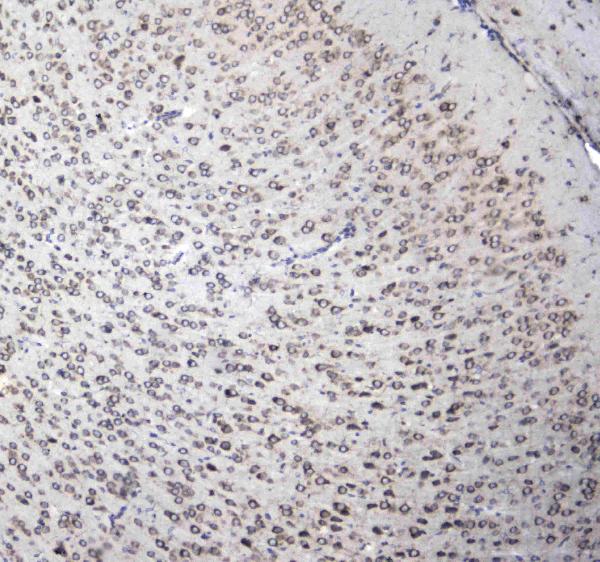
Click image to see more details
Figure 2. IHC analysis of L1CAM using anti-L1CAM antibody (A00729-1).
L1CAM was detected in paraffin-embedded section of mouse brain tissue. Heat mediated antigen retrieval was performed in citrate buffer (pH6, epitope retrieval solution) for 20 mins. The tissue section was blocked with 10% goat serum. The tissue section was then incubated with 1μg/ml rabbit anti-L1CAM Antibody (A00729-1) overnight at 4°C. Biotinylated goat anti-rabbit IgG was used as secondary antibody and incubated for 30 minutes at 37°C. The tissue section was developed using Strepavidin-Biotin-Complex (SABC)(Catalog # SA1022) with DAB as the chromogen.
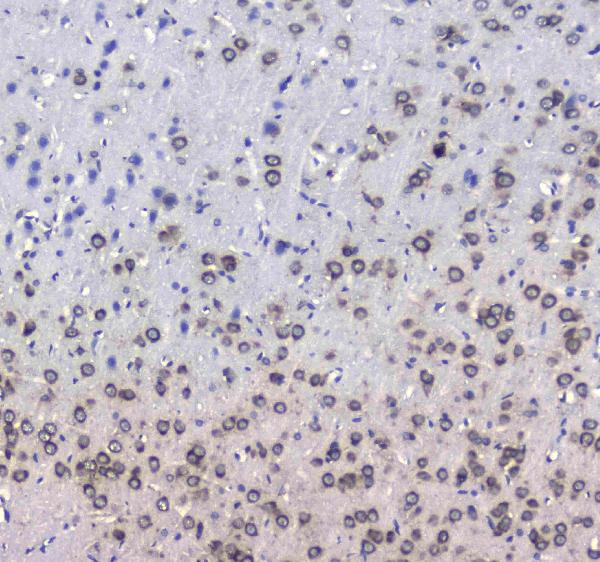
Click image to see more details
Figure 3. IHC analysis of L1CAM using anti-L1CAM antibody (A00729-1).
L1CAM was detected in paraffin-embedded section of rat brain tissue. Heat mediated antigen retrieval was performed in citrate buffer (pH6, epitope retrieval solution) for 20 mins. The tissue section was blocked with 10% goat serum. The tissue section was then incubated with 1μg/ml rabbit anti-L1CAM Antibody (A00729-1) overnight at 4°C. Biotinylated goat anti-rabbit IgG was used as secondary antibody and incubated for 30 minutes at 37°C. The tissue section was developed using Strepavidin-Biotin-Complex (SABC)(Catalog # SA1022) with DAB as the chromogen.
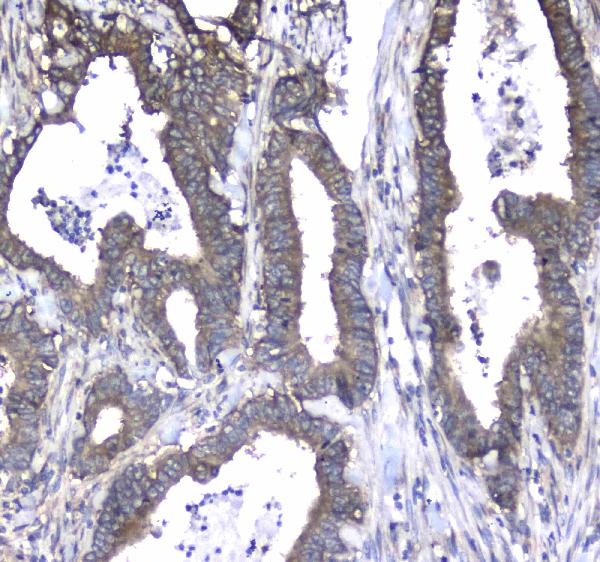
Click image to see more details
Figure 4. IHC analysis of L1CAM using anti-L1CAM antibody (A00729-1).
L1CAM was detected in paraffin-embedded section of human colon cancer tissue. Heat mediated antigen retrieval was performed in citrate buffer (pH6, epitope retrieval solution) for 20 mins. The tissue section was blocked with 10% goat serum. The tissue section was then incubated with 1μg/ml rabbit anti-L1CAM Antibody (A00729-1) overnight at 4°C. Biotinylated goat anti-rabbit IgG was used as secondary antibody and incubated for 30 minutes at 37°C. The tissue section was developed using Strepavidin-Biotin-Complex (SABC)(Catalog # SA1022) with DAB as the chromogen.
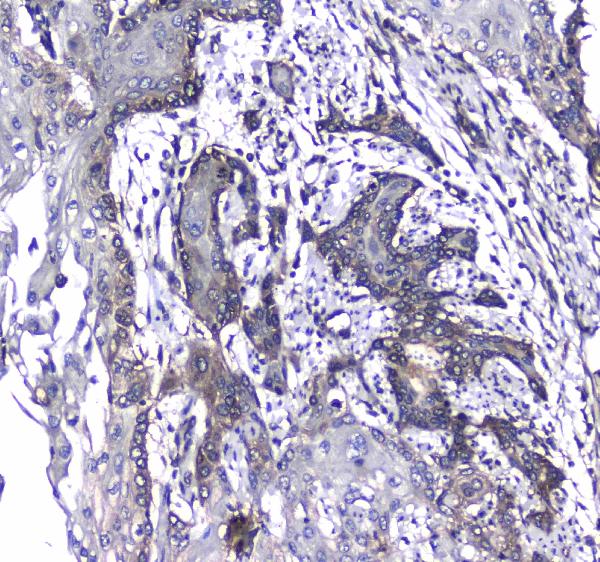
Click image to see more details
Figure 5. IHC analysis of L1CAM using anti-L1CAM antibody (A00729-1).
L1CAM was detected in paraffin-embedded section of human glioma tissue. Heat mediated antigen retrieval was performed in citrate buffer (pH6, epitope retrieval solution) for 20 mins. The tissue section was blocked with 10% goat serum. The tissue section was then incubated with 1μg/ml rabbit anti-L1CAM Antibody (A00729-1) overnight at 4°C. Biotinylated goat anti-rabbit IgG was used as secondary antibody and incubated for 30 minutes at 37°C. The tissue section was developed using Strepavidin-Biotin-Complex (SABC)(Catalog # SA1022) with DAB as the chromogen.
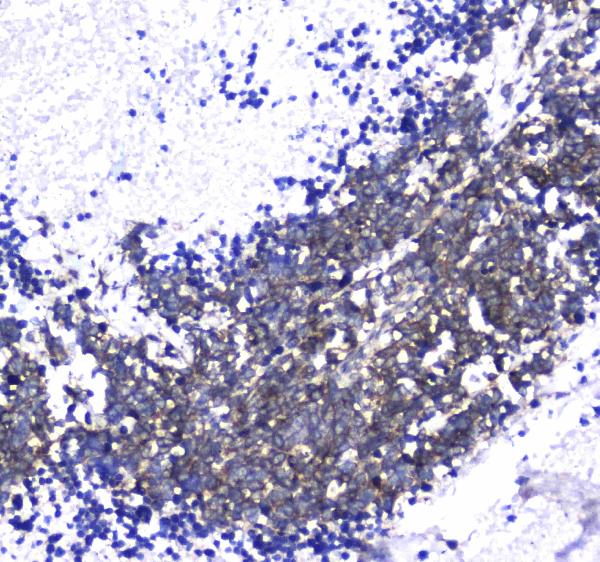
Click image to see more details
Figure 6. IHC analysis of L1CAM using anti-L1CAM antibody (A00729-1).
L1CAM was detected in paraffin-embedded section of human lung cancer tissue. Heat mediated antigen retrieval was performed in citrate buffer (pH6, epitope retrieval solution) for 20 mins. The tissue section was blocked with 10% goat serum. The tissue section was then incubated with 1μg/ml rabbit anti-L1CAM Antibody (A00729-1) overnight at 4°C. Biotinylated goat anti-rabbit IgG was used as secondary antibody and incubated for 30 minutes at 37°C. The tissue section was developed using Strepavidin-Biotin-Complex (SABC)(Catalog # SA1022) with DAB as the chromogen.
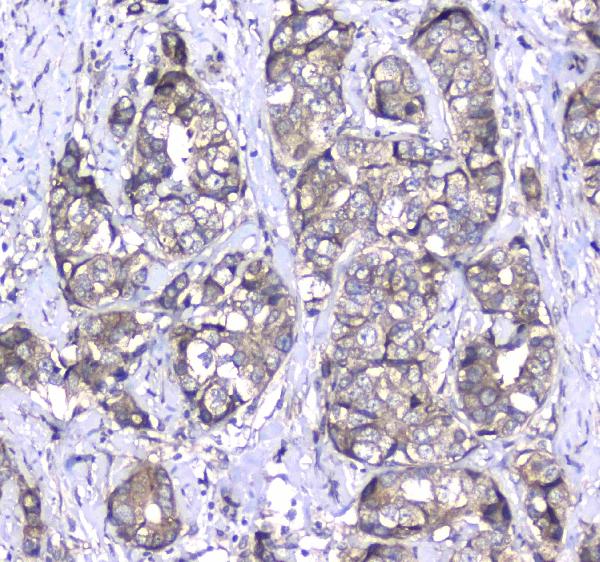
Click image to see more details
Figure 7. IHC analysis of L1CAM using anti-L1CAM antibody (A00729-1).
L1CAM was detected in paraffin-embedded section of human mammary cancer tissue. Heat mediated antigen retrieval was performed in citrate buffer (pH6, epitope retrieval solution) for 20 mins. The tissue section was blocked with 10% goat serum. The tissue section was then incubated with 1μg/ml rabbit anti-L1CAM Antibody (A00729-1) overnight at 4°C. Biotinylated goat anti-rabbit IgG was used as secondary antibody and incubated for 30 minutes at 37°C. The tissue section was developed using Strepavidin-Biotin-Complex (SABC)(Catalog # SA1022) with DAB as the chromogen.
Protein Target Info & Infographic
Gene/Protein Information For L1CAM (Source: Uniprot.org, NCBI)
Gene Name
L1CAM
Full Name
Neural cell adhesion molecule L1
Weight
140.003kDa
Superfamily
immunoglobulin superfamily
Alternative Names
Neural cell adhesion molecule L1; N-CAM-L1; NCAM-L1; CD171; L1CAM; CAML1; MIC5 L1CAM CAML1, CD171, HSAS, HSAS1, MASA, MIC5, N-CAM-L1, N-CAML1, NCAM-L1, S10, SPG1 L1 cell adhesion molecule neural cell adhesion molecule L1| by R1
*If product is indicated to react with multiple species, protein info is based on the gene entry specified above in "Species".For more info on L1CAM, check out the L1CAM Infographic

We have 30,000+ of these available, one for each gene! Check them out.
In this infographic, you will see the following information for L1CAM: database IDs, superfamily, protein function, synonyms, molecular weight, chromosomal locations, tissues of expression, subcellular locations, post-translational modifications, and related diseases, research areas & pathways. If you want to see more information included, or would like to contribute to it and be acknowledged, please contact [email protected].
Specific Publications For Anti-L1CAM Antibody (A00729-1)
Hello CJ!
No publications found for A00729-1
*Do you have publications using this product? Share with us and receive a reward. Ask us for more details.
Recommended Resources
Here are featured tools and databases that you might find useful.
- Boster's Pathways Library
- Protein Databases
- Bioscience Research Protocol Resources
- Data Processing & Analysis Software
- Photo Editing Software
- Scientific Literature Resources
- Research Paper Management Tools
- Molecular Biology Software
- Primer Design Tools
- Bioinformatics Tools
- Phylogenetic Tree Analysis
Customer Reviews
Have you used Anti-L1CAM Antibody?
Submit a review and receive an Amazon gift card.
- $30 for a review with an image
0 Reviews For Anti-L1CAM Antibody
Customer Q&As
Have a question?
Find answers in Q&As, reviews.
Can't find your answer?
Submit your question
15 Customer Q&As for Anti-L1CAM Antibody
Question
Will anti-L1CAM antibody A00729-1 work for IHC with cervix carcinoma?
Verified Customer
Verified customer
Asked: 2020-04-08
Answer
According to the expression profile of cervix carcinoma, L1CAM is highly expressed in cervix carcinoma. So, it is likely that anti-L1CAM antibody A00729-1 will work for IHC with cervix carcinoma.
Boster Scientific Support
Answered: 2020-04-08
Question
Is this A00729-1 anti-L1CAM antibody reactive to the isotypes of L1CAM?
Verified Customer
Verified customer
Asked: 2019-06-26
Answer
The immunogen of A00729-1 anti-L1CAM antibody is A synthetic peptide corresponding to a sequence of human L1CAM (NMVITWKPLRWMDWNAPQVQYRVQWRPQGTRGPW). Could you tell me which isotype you are interested in so I can help see if the immunogen is part of this isotype?
Boster Scientific Support
Answered: 2019-06-26
Question
We appreciate helping with my inquiry over the phone. Here are the WB image, lot number and protocol we used for cervix carcinoma using anti-L1CAM antibody A00729-1. Let me know if you need anything else.
Verified Customer
Verified customer
Asked: 2019-04-12
Answer
Thanks for the data. You have provided everything we needed. Our lab team are working to resolve your inquiry as quickly as possible, and we appreciate your patience and understanding! Please let me know if there is anything you need in the meantime.
Boster Scientific Support
Answered: 2019-04-12
Question
Is a blocking peptide available for product anti-L1CAM antibody (A00729-1)?
Verified Customer
Verified customer
Asked: 2018-12-26
Answer
We do provide the blocking peptide for product anti-L1CAM antibody (A00729-1). If you would like to place an order for it please contact [email protected] and make a special request.
Boster Scientific Support
Answered: 2018-12-26
Question
I see that the anti-L1CAM antibody A00729-1 works with IHC, what is the protocol used to produce the result images on the product page?
Verified Customer
Verified customer
Asked: 2018-12-26
Answer
You can find protocols for IHC on the "support/technical resources" section of our navigation menu. If you have any further questions, please send an email to [email protected]
Boster Scientific Support
Answered: 2018-12-26
Question
Do you have a BSA free version of anti-L1CAM antibody A00729-1 available?
L. Zhang
Verified customer
Asked: 2018-12-11
Answer
Thank you for your recent telephone inquiry. I can confirm that some lots of this anti-L1CAM antibody A00729-1 are BSA free. For now, these lots are available and we can make a BSA free formula for you free of charge. It will take 3 extra days to prepare. If you require this antibody BSA free again in future, please do not hesitate to contact me and I will be pleased to check which lots we have in stock that are BSA free.
Boster Scientific Support
Answered: 2018-12-11
Question
I was wanting to use your anti-L1CAM antibody for IHC for human cervix carcinoma on frozen tissues, but I want to know if it has been validated for this particular application. Has this antibody been validated and is this antibody a good choice for human cervix carcinoma identification?
R. Singh
Verified customer
Asked: 2017-09-26
Answer
As indicated on the product datasheet, A00729-1 anti-L1CAM antibody has been validated for IHC on human, mouse, rat tissues. We have an innovator award program that if you test this antibody and show it works in human cervix carcinoma in IHC-frozen, you can get your next antibody for free.
Boster Scientific Support
Answered: 2017-09-26
Question
We are interested in to test anti-L1CAM antibody A00729-1 on human cervix carcinoma for research purposes, then I may be interested in using anti-L1CAM antibody A00729-1 for diagnostic purposes as well. Is the antibody suitable for diagnostic purposes?
Verified Customer
Verified customer
Asked: 2017-06-02
Answer
The products we sell, including anti-L1CAM antibody A00729-1, are only intended for research use. They would not be suitable for use in diagnostic work. If you have the means to develop a product into diagnostic use, and are interested in collaborating with us and develop our product into an IVD product, please contact us for more discussions.
Boster Scientific Support
Answered: 2017-06-02
Question
Our team were satisfied with the WB result of your anti-L1CAM antibody. However we have been able to see positive staining in cervix carcinoma cell membrane using this antibody. Is that expected? Could you tell me where is L1CAM supposed to be expressed?
J. Krishna
Verified customer
Asked: 2016-12-21
Answer
From what I have seen in literature, cervix carcinoma does express L1CAM. Generally L1CAM expresses in cell membrane. Regarding which tissues have L1CAM expression, here are a few articles citing expression in various tissues:
Cervix carcinoma, Pubmed ID: 17081983, 18669648, 20068231, 23186163
Fetal brain, Pubmed ID: 1769655, 1923824, 1932117
Liver, Pubmed ID: 19159218
Pancreas, Pubmed ID: 15489334
Plasma, Pubmed ID: 16335952
Boster Scientific Support
Answered: 2016-12-21
Question
We are currently using anti-L1CAM antibody A00729-1 for mouse tissue, and we are happy with the IHC results. The species of reactivity given in the datasheet says human, mouse, rat. Is it true that the antibody can work on goat tissues as well?
L. Wu
Verified customer
Asked: 2016-10-25
Answer
The anti-L1CAM antibody (A00729-1) has not been validated for cross reactivity specifically with goat tissues, but there is a good chance of cross reactivity. We have an innovator award program that if you test this antibody and show it works in goat you can get your next antibody for free. Please contact me if I can help you with anything.
Boster Scientific Support
Answered: 2016-10-25
Question
We have observed staining in mouse fetal brain. What should we do? Is anti-L1CAM antibody supposed to stain fetal brain positively?
D. Edwards
Verified customer
Asked: 2016-05-31
Answer
Based on literature fetal brain does express L1CAM. Based on Uniprot.org, L1CAM is expressed in right hemisphere of cerebellum, fetal brain, pancreas, plasma, cervix carcinoma, liver, among other tissues. Regarding which tissues have L1CAM expression, here are a few articles citing expression in various tissues:
Cervix carcinoma, Pubmed ID: 17081983, 18669648, 20068231, 23186163
Fetal brain, Pubmed ID: 1769655, 1923824, 1932117
Liver, Pubmed ID: 19159218
Pancreas, Pubmed ID: 15489334
Plasma, Pubmed ID: 16335952
Boster Scientific Support
Answered: 2016-05-31
Question
Does A00729-1 anti-L1CAM antibody work on parafin embedded sections? If so, which fixation method do you recommend we use (PFA, paraformaldehyde, other)?
M. Krishna
Verified customer
Asked: 2016-01-25
Answer
You can see on the product datasheet, A00729-1 anti-L1CAM antibody as been tested on IHC. It is best to use PFA for fixation because it has better tissue penetration ability. PFA needs to be prepared fresh before use. Long term stored PFA turns into formalin, as the PFA molecules congregate and become formalin.
Boster Scientific Support
Answered: 2016-01-25
Question
I have attached the WB image, lot number and protocol we used for cervix carcinoma using anti-L1CAM antibody A00729-1. Please let me know if you require anything else.
J. Lewis
Verified customer
Asked: 2014-07-29
Answer
Thank you very much for the data. Our lab team are working to resolve this as quickly as possible, and we appreciate your patience and understanding! You have provided everything we needed. Please let me know if there is anything you need in the meantime.
Boster Scientific Support
Answered: 2014-07-29
Question
I am looking for using your anti-L1CAM antibody for axon development studies. Has this antibody been tested with western blotting on colon cancer tissue? We would like to see some validation images before ordering.
B. Taylor
Verified customer
Asked: 2013-08-29
Answer
Thanks for your inquiry. This A00729-1 anti-L1CAM antibody is validated on mouse brain, brain tissue, rat brain tissue, human glioma tissue, colon cancer tissue, lung cancer tissue, mammary cancer tissue. It is guaranteed to work for IHC in human, mouse, rat. Our Boster guarantee will cover your intended experiment even if the sample type has not been be directly tested.
Boster Scientific Support
Answered: 2013-08-29
Question
Can you help my question with product A00729-1, anti-L1CAM antibody. I was wondering if it would be possible to conjugate this antibody with biotin. I would need it to be without BSA or sodium azide. I am planning on using a buffer exchange of sodium azide with PBS only. Would there be problems for me to conjugate the antibody and store it in -20 degrees in small aliquots?
N. Zhang
Verified customer
Asked: 2013-04-15
Answer
It is not recommended storing this antibody with PBS buffer only in -20 degrees. If you want to store it in -20 degrees it is best to add some cryoprotectant like glycerol. If you want carrier free A00729-1 anti-L1CAM antibody, we can provide it to you in a special formula with trehalose and/or glycerol. These molecules will not interfere with conjugation chemistry and provide a good level of protection for the antibody from degradation. Please be sure to specify this in your purchase order.
Boster Scientific Support
Answered: 2013-04-15




